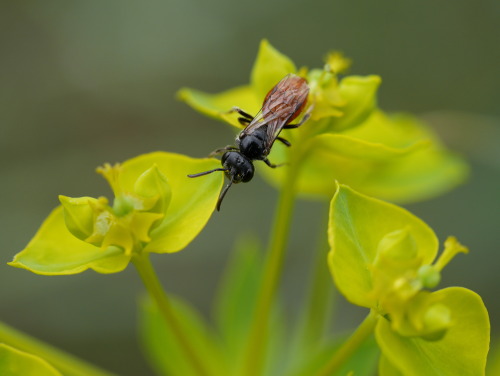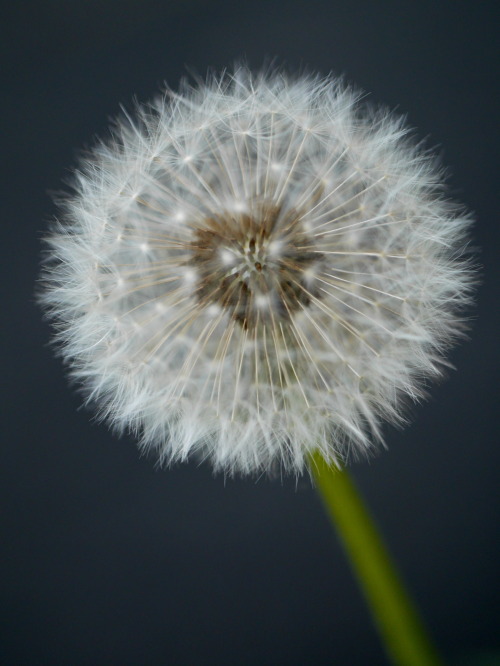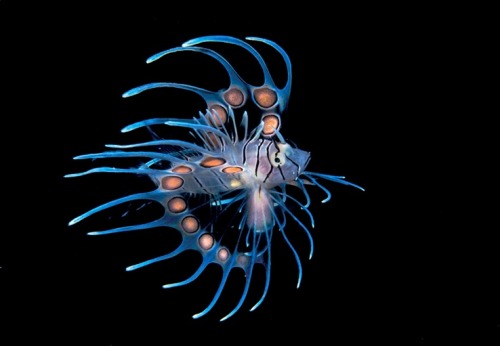#introduced species
Sphecodes(arvensiformis) “Cuckoo Sweat Bee” Halictidae
onEuphorbia esula “Leafy Spurge” Euphorbiaceae
Blue Mountain National Recreation Area, MT
May 16, 2016
Robert Niese
Sphecodesbees are cleptoparasitic, cuckoo-like bees that lay their eggs in the nests of other sweat bees. Despite their outward appearance, these insects are not wasps, but they have converged on a very cuckoo-wasp-like life-history strategy. A female enters the nests of another Halictid, consumes a developing egg and replaces it with her own. Unfortunately, these bees, like the vast majority of Halictids, are very poorly studied and there are few entomologists capable of accurately identifying them beyond the genus level. Oh, and by the way, Leafy Spurge, while it is one of Missoula’s most widespread invasives, is also one of my favorite spring plants. They’re just such odd organisms! More photos and natural history info to come, I’m sure.
Looking back at my other photos of these bees from years ago makes me realize how far my skills as a photographer and natural historian have progressed.
Post link
Taraxacum officinale “Common Dandelion” Asteraceae (Compositae)
Missoula, MT
May 2, 2016
Robert Niese
Generic, but beautiful nonetheless. Each of those tiny wind dancers is actually a fruit called an achene. Each achene arose from an individual flower of which there are hundreds in a single dandelion head (actually there are only 50-200 flowers per head, but “hundreds” sounds better) . This is where the family got its old name, “Compositae.” Each of their composite “flowers” are made up of loads of tiny individual flowers. So next time your lover asks for flowers, pick them a couple dandelions and astound them with an offering of many hundreds of flowers instead of a measly dozen roses.
Post link
Trachemys scripta elegans “Red-eared Pond Slider” Emydidae
Washington Park Arboretum, Seattle, WA
May 9, 2016
Robert Niese
Red-eared Sliders are a distinct subspecies of Pond Slider popular in the pet industry. Originally native to the southern US, these animals have been introduced to nearly every state including Hawaii, Puerto Rico, and Guam. As such, they are on the IUCN’s list of the 100 most invasive species in the world. They have not yet been reported in Montana, Alaska, Wyoming, Utah, Nevada, or North Dakota. If you see a Red-eared Slider in one of these states, contact your state’s Fish and Wildlife department immediately. Here in the PNW, these turtles out-compete native Western Painted Turtles (Chrysemys picta bellii) and the threatened Western Pond Turtle (Actinemys marmorata).
Post link
Young Invader
This is a juvenile red lionfish(Pterois volitans). As it matures, those conspicuous pectoral fin spots will disappear, and it will develop the striking brownish-red stripes characteristic of its adult form.
While originally found in the Indo-Pacific region, P.volitans has become an invasive species in the Northwestern Atlantic and the Caribbean, possibly through introduction as released exotic pets.
Their pelagic larval phase (not shown here) has certainly helped their invasive cause. As tiny larvae, they ride the currents, allowing them to disperse and establish populations throughout their new ‘home’.
As invaders, they have the potential to upset the balance of local reef ecosystems, affect fisheries production, and threaten human health (since, being members of the Scorpaenidae family, they are venomous).
Image source: Discover Magazine
Reference:Morris et al. 2009.
Post link




